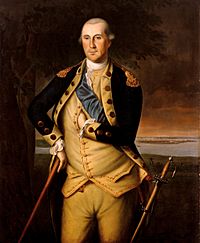New York and New Jersey Campaign facts for kids

The New York and New Jersey campaign was a major part of the American Revolutionary War. It involved many battles in 1776 and early 1777. The main goal was to control New York City and the state of New Jersey.
The fight was between the British army, led by General Sir William Howe, and the American Continental Army, led by General George Washington. General Howe managed to push Washington's army out of New York City. However, he spread his troops too thin in New Jersey. The campaign ended in January 1777 with the British holding only a few small areas near New York City. The British kept control of New York Harbor for the rest of the war. They used it as a main base for other attacks.
Contents
Starting the Campaign: British Landings
The British army first arrived on Staten Island on July 3, 1776. They landed without any fighting. This army included soldiers who had left Boston earlier that year. More British troops joined them. They also had Hessian soldiers, who were hired from German states.
General Washington's army had soldiers from New England and states as far south as Virginia.
Battles on Long Island and Manhattan
In August, General Howe's troops landed on Long Island. They defeated Washington's army in the Battle of Long Island. This was the largest battle of the entire war. But the American army managed to escape. They retreated safely to Manhattan under the cover of darkness and fog.
Washington's army faced more defeats in Manhattan. One small victory was a skirmish at Harlem Heights. Eventually, Washington pulled his troops back to White Plains, New York. General Howe then went back to Manhattan. He captured the American forces Washington had left behind on the northern part of the island.
Retreat and a Surprise Attack
Washington and most of his army then crossed the Hudson River into New Jersey. They kept retreating all the way across the Delaware River into Pennsylvania. The American army was getting smaller. Many soldiers' enlistment times were ending. Others left, and morale was low.
In December, General Howe sent his troops into winter camps. He set up a line of outposts from New York to Burlington, New Jersey.
Washington's Bold Move at Trenton
Washington then made a very brave move. He crossed the icy Delaware River on Christmas night. This was a huge boost for American morale. He launched a successful surprise attack on the British outpost at Trenton.
Because of this attack, Howe pulled his outposts back. They moved closer to New Brunswick and the coast near New York. Washington set up his own winter camp at Morristown.
Winter Skirmishes
During the rest of the winter, both sides had frequent small fights. These were called the Forage War. The British were often looking for food and supplies for their army.
After the Campaign
Britain kept control of New York City and the areas around it until the war ended in 1783. They used it as a base for other military actions in North America.
In 1777, General Howe started a new campaign. He tried to capture Philadelphia. He left General Sir Henry Clinton in charge of the New York area. Meanwhile, General John Burgoyne tried to gain control of the Hudson River valley. He moved south from Quebec. But his attempt failed at Saratoga.
Northern New Jersey continued to see small battles and skirmishes. This went on for the rest of the war.
Images for kids
-
General William Howe, 1777 mezzotint
-
Military map by Claude Joseph Sauthier showing troop movements before, during, and after the Battle of White Plains
-
Depiction of the British landing at the Palisades near Fort Lee, New Jersey. Watercolor attributed to Thomas Davies
-
Emanuel Leutze's 1851 painting Washington Crossing the Delaware is an iconic image of American history.
-
A plaque commemorating the Battle of Harlem Heights on the Math Building at Columbia University
See also
 In Spanish: Campaña de Nueva York y Nueva Jersey para niños
In Spanish: Campaña de Nueva York y Nueva Jersey para niños











